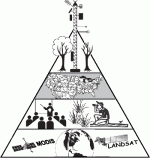A critical tool for enabling adaptive responses to climate change
Phenology is a sensitive measure of climatic variation and change, is relatively simple to record and understand, and is vital to both the scientific and public interest with or without climate change. Integration of spatially-extensive phenological data and models with both short and long-term climatic forecasts offer a powerful and necessary agent for human adaptation to ongoing climate change. However, the predictive potential of phenology requires a new data resource-a national network of integrated phenological observations and the tools to access and analyze them at multiple scales.
The USA National Phenology Network (NPN) is an emerging partnership between federal agencies, the academic community, and the general public to monitor and understand the influence of seasonal cycles on the nation's biological resources. The goal of the NPN (www.usanpn.org) is to establish a wall-to-wall science and monitoring initiative focused on phenology, the study of the causes and consequences of life cycle events for individuals and populations of plants and animals.
Periodic plant and animal life cycles driven by seasonal variations in climate set the stage for the dynamics of the ecosystem processes, determine land surface properties, control biosphere-atmosphere interactions, and affect food production, health, conservation, and recreation. Information from phenological research can be used at local to national scales for scientific research, education and outreach, and by stakeholders interested in agriculture, tourism and recreation, human health, and natural resource conservation and management.
A primary goal of the NPN is to enhance the mitigation and adaptation strategies for climate change by building and supporting the first coordinated effort by scientists, naturalists, and the general public to detect and to predict the trajectory of climate change through the accumulation and analysis of daily observations of the natural world. It is intended as a large-scale network of repeated and integrated plant and animal phenological observations, linked with other relevant data sources and the tools to analyze these data at local to national scales. The network will also integrate remote sensing data from satellites with on-the-ground phenological observations by students from educational institutions at all levels, by private citizens and naturalist groups, and by technical staff and volunteers who already take other field measurements across existing environmental networks (Figure 1).
Recent accomplishments include three planning, interdisciplinary workshops in August 2005, October 2006, and August 2007 supported by the National Science Foundation and six other federal agencies, several symposia at national conferences, and a half-million dollar, five-year Research Coordination Network grant from NSF beginning in 2007. The University of Arizona and the U.S. Geological Survey collaborated in 2007 to establish and staff a National Coordination Office (NCO) in Tucson. The NCO is collaborating with the University of Wisconsin-Milwaukee and Oak Ridge National Laboratories to construct a functional data collection system for individual observations, using a common architecture and common database schema. About 200 widely-distributed and common species have been selected for national monitoring, including development and vetting of observation protocols. A revised and expanded USA-NPN website will be ready for data entry later in 2008.
The USA-NPN Plant Phenology Program has already registered over 800 individuals who are observing native species and cloned lilacs across 49 states. The program is negotiating memoranda of understanding with federal agencies and environmental networks, including National Park Service Inventory & Monitoring, Organization of Biological Field Stations, the National Ecological Observatory Network and LTER. Planning for regional networks modeled after the national one has advanced quickly in the northeastern U.S. (www.nerpn.org), and is in the initial stages in the southeast and southwest. A national campaign to engage private citizens, Project Budburst (www.budburst.org), was successfully launched in spring 2007 and expanded in spring 2008 by the University Corporation for Atmospheric Research and other partnerships. UC-Santa Barbara and Virginia Tech University are collaborating to develop curricula in phenology and student-led monitoring and research programs that can be customized for implementation at any university.
As brief as our history may be, NPN values its collaborations with the LTER Network and affiliated scientists, and is fully committed to advancing and strengthening future collaborations. The February 2007 Phenology Workshop is a good example of our successful collaboration. The week-long workshop, supported by the LTER Network Office, brought together researchers to define the state of phenological research across LTER and to provide recommendations to advance the integrative use of phenological data within, across, and beyond LTER sites. A report documenting the results and recommendations of this workshop are posted on the NPN webpage, www.usanpn.org.
Jake F. Weltzin is Executive Director, USA NPN National Coordinating Office
Mark Losleben is Assistant Director, USA NPN National Coordinating Office

 Enlarge this image
Enlarge this image